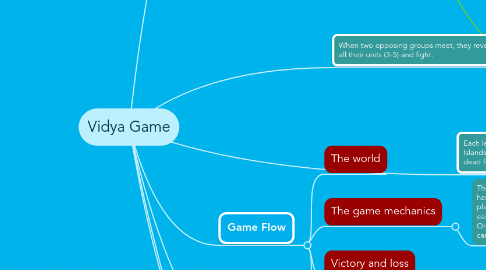
1. Each level is a new map in a new 3D world. Islands, mountains, cities, stomachs of flying dead fish. No two maps are the same.
2. Sitting around will not win battles. The enemy is after your crystal, which is essentially the player's life force. Likewise, you are after the opponent's crystal. You win by destroying your opponent's crystal. You lose when your opponent destroys your crystal or kills all your units.
3. When two opposing groups meet, they reveal all their units (3-5) and fight.
3.1. Example: A group led by a knight meets a group led by a wizard. Two golems appear in front of the wizards (its a video game) and 4 soldiers appear by the knight. The two forces fight in real time with the player controlling the leader. The fight ends once one force is defeated.
3.1.1. I may abolish the 3-5 member groups and just have 1 single member for this game. Also, when a fight occurs the rest of the game freezes still until the fight is finished
3.2. Inspiration comes from Xenoblade and FFXII.
4. Players earn a pool of experience points. You can use these points to upgrade unit's stats. You can dump them all into one unit or split them up. Afterwards, the player is sent to a giant world map where they pick the next level.
4.1. Example: Increasing Agility will boost a unit's speed on the map and in battle. Strength will benefit their physical attack damage and physical attack defense.
5. Gameplay
5.1. Real-Time Strategy
5.1.1. Control of single groups that the players can move around a map. Different types of terrain dictate how fast or slow a group can move based on the group's affinity.
5.1.1.1. Example: A wolf will move around easily on mountains and forests, but not rivers. Merfish however can, but mountain climbing will be near impossible.
5.1.1.1.1. Ideally I would have a vast variety of mythological monsters, but seeing as I will have to model each one I may keep it at a minimum with color changing pallets. Soldiers, knights, dark knights and paladins will all look the same, just colored differently.
5.1.1.2. Inspiration comes from Ogre Battle: MotBQ and Ogre Battle 64.
5.2. Turn-based Tactics
5.2.1. There is a limit to how far and how fast each group can move per turn. However, all group's turn cooldown occur simultaneously - players need to be fast.
5.2.1.1. Example: You finish moving a group that takes 10 seconds to move again. You spend the next 5 second working with another group. The first group will become "active" in 5 seconds.
5.2.1.1.1. The UI will provide bars and avatars showing when each unit is ready to move.
5.2.1.2. Inspiration comes from the tactics genre as a whole, only with an additional spin.
5.3. Action
6. Game Flow
6.1. The world
6.2. The game mechanics
6.2.1. The opponent has a large army, but the player has individual and powerful units. One of the player's heroes can defeat an enemy soldier easily, but not when 5 are fighting together. Only when the player works all units together can they defeat the enemy.
6.2.1.1. Each hero is vitally important and unique in their own way, sort of like in DOTA. There are the many generic units and then there are the champions.
6.3. Victory and loss
6.4. After the battle
7. Multiplayer
7.1. Competitive
7.1.1. One or more players fight on opposing sides, each using units similar to the style of single-player mode. Gameplay tweaks, such as revival of fallen units need to be implemented for balance
7.2. Co-operative
7.2.1. Two or more players control a smaller army of units in exchange for two players working together.
